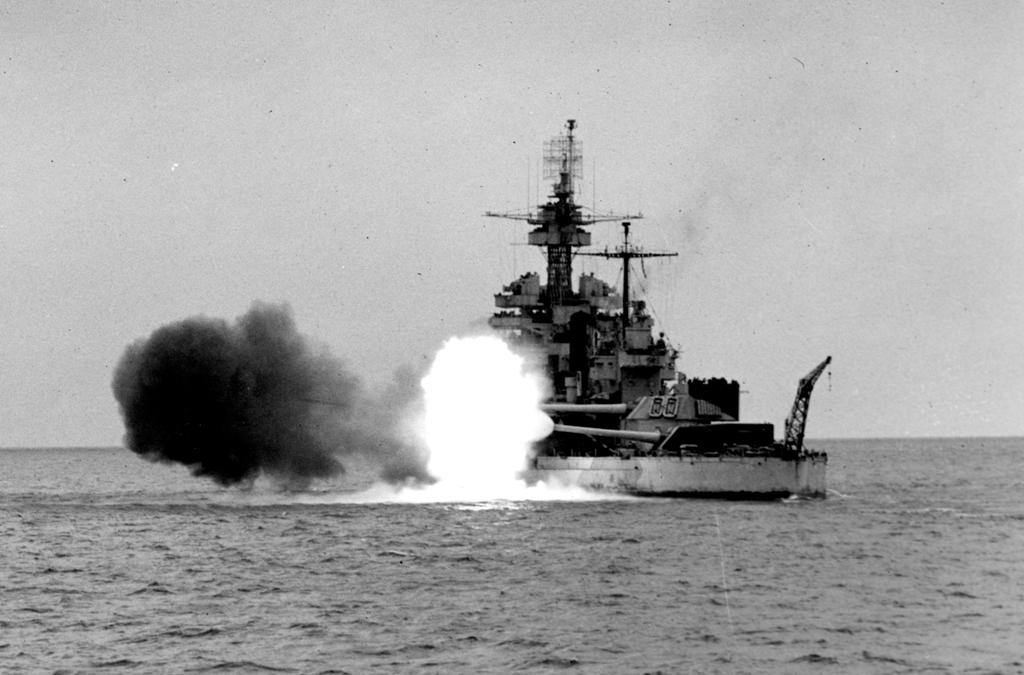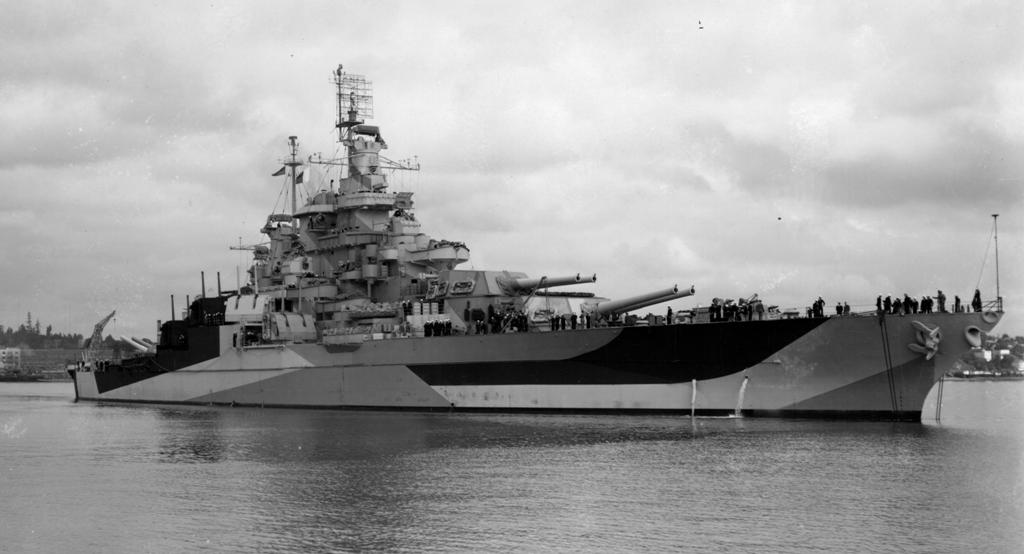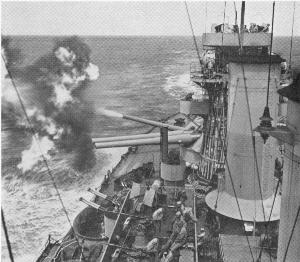
Used only on the USS Colorado (BB-45) class battleships, these guns were reconstructed from the original 16"/45 (40.6 cm) Mark 1 weapons during the 1930s modernization of the battlefleet. The major difference from the Mark 1 gun was the redesign of the chamber to permit larger charges, a new liner with heavier taper carbon steel, liner-locking ring and locking collar. A later version, the Mark 8, was similar except that rifling was uniform and the bore was chromium plated for increased life.
These ships could not fire the "super-heavy" 2,700 pound (1,224.7 kg) AP Mark 8 projectile, as that shell was too heavy and too long for their handling equipment. However, in the late 1930s they were given the 2,240 lbs. (1,016 kg) AP Mark 5, which was a heavier projectile with better armor piercing capability than the 2,110 lbs. (957.1 kg) AP Mark 3 that was originally issued. By 1942, these ships were also issued an HC projectile.
The data that follows is specifically for the 16"/45 (40.6 cm) Mark 5 Mod 1 unless otherwise noted.
| Designation | 16"/45 (40.6 cm) Mark 5 and Mark 8 |
|---|---|
| Ship Class Used On | Colorado (BB-45) Class |
| Date Of Design | about 1935 |
| Date In Service | about 1938 |
| Gun Weight | 235,796 lbs. (106,959 kg) (including breech)
230,948 lbs. (104,757 kg) (without breech) |
| Gun Length oa | 736.0 in (18.694 m) |
| Bore Length | 720.0 in (18.288 m) |
| Rifling Length | 616.9 in (15.668 m) |
| Grooves | 96 |
| Lands | N/A |
| Twist | Mark 5: Increasing RH 1 in 50 to 1 in 32
Mark 8: Uniform RH 1 in 25 |
| Chamber Volume | 23,506 in3 (385.3 dm3) |
| Rate Of Fire 1 | about 1.5 rounds per minute |
- ^USS West Virginia (BB-48) was thoroughly modernized during reconstruction following damage received during the Pearl Harbor attack. She was given modern fire control equipment and radar. During the Battle of Surigao Strait on 25 October 1944, West Virginia fired thirteen full salvos under full radar control using the after Mark 8 Mod 2 radar. Rapid salvo fire was used after the second salvo and the average time between salvos was 41 seconds. Opening gun range was 22,400 yards (20,480 m) and average range was 20,880 yards (19,090 m). The first salvo fired was a straddle with hits being observed and all subsequent full salvos were straddles. The right gun of turret 1 missed 3 salvos and the right gun of turret 3 missed 7 salvos. These missed salvos were primarily due to shell hoist casualties in those two mountings. From her gunnery report:
"A total of 89 A.P. and 4 H.C. projectiles were fired, all with service charges. Due to shell hoist casualties in turrets 1 and 3 and the lack of supply in turret 4, the Gun Captains loaded H.C. projectiles, which were available on the table, when there were no A.P. available. Turret 3 fired one H.C. on the 6th salvo. Turret 1 fired one H.C. on each of the 9th and 10th salvos. Turret 4 fired one H.C. on the 15th salvo. Turret 2 was slow on loading after the 12th salvo and missed the 13th salvo. Turret 4 had two projectiles rammed at cease firing and was ordered to continue the load. The left gun misfired on the 15th salvo necessitating a 16th salvo."
- The bore of the Mark 8 was chromium plated for a distance of 625 inches (15.875 m) from the muzzle.
| Type | Bag |
|---|---|
| Projectile Types and Weights | AP Mark 5 Mods 1 to 6 1a - 2,240 lbs. (1,016 kg)
HC Mark 13 Mods 0 to 6 2a - 1,900 lbs. (862 kg) HC Mark 14 Mod 0 - 1,900 lbs. (862 kg) Target Mark 6 - 2,240 lbs. (1,016 kg) 3a Target Mark 7 - 2,240 lbs. (1,016 kg) |
| Bursting Charge | AP Mark 5 - 33.6 lbs. (15.2 kg)
HC Mark 13 - 153.6 lbs. (69.67 kg) HC Mark 14 - 153.6 lbs. (69.67 kg) |
| Projectile Length | AP Mark 5 - 64.0 in (162.6 cm)
HC Mark 13 - 64.0 in (162.6 cm) HC Mark 14 - 64.0 in (162.6 cm) |
| Propellant Charge 4a | Full Charge - 545.0 lbs. (247.2 kg) SPD
Reduced Charge - 295.0 lbs. (133.8 kg) SPD or SPDN
|
| Muzzle Velocity | Full Charge - New Gun
AP - 2,520 fps (768 mps) HC - 2,635 fps (803 mps) Reduced Charge - New Gun
|
| Working Pressure | 18.0 tons/in2 (2,835 kg/cm2) |
| Approximate Barrel Life | Mark 5: 320 rounds
Mark 8: 395 rounds |
| Ammunition stowage per gun | 100 rounds 5a |
- ^The AP Mark 5 was a major change to a hard-capped, sheath-hardened AP projectile that could penetrate caliber-thickness face-hardened armor at 30 to 40 degree obliquity (this was its test specification). It gained most of its extra weight by reducing the filler to only 1.5% of its total weight and by using a thicker, wider, high-hardness AP cap. These projectiles with a different fuze adapter and base fuze were issued to the U.S. Army Coast Defense Command as the AP Mark 12. These Mark 5 and Mark 12 projectiles had a very blunt - though still pointed - body nose under the AP cap to improve their high-obliquity penetration of medium-thickness homogeneous deck and turret roof armor. The AP Mark 5 projectiles were designed to be used in long-range gun actions against Japanese ships ("Plan Orange") and for that reason they were to be fired at relatively low muzzle velocities and high gun elevations. These conditions would result in a steeper angle of fall in order to enhance their deck armor penetration capabilities.
- ^For information on the HC Mark 13 and HC Mark 14, see the 16"/50 (40.6 cm) Mark 7 data page.
- ^Target Mark 5 used blind loaded and plugged (BL&P) AP Mark 5 projectile bodies. The Mark 7 was identical to the Mark 6 but used a dye spotting load.
- ^All propellant charges were in five bags.
- ^Following her rebuild after being damaged at Pearl Harbor, USS West Virginia (BB-48) carried 90 rounds per gun.
- After 1941 AP rounds had a nominal 1.5 lbs. (0.68 kg) dye bag added but this was allowed to be as large as 3.0 lbs. (1.36 kg) in order to bring underweight projectiles up to standard.
These ships were assigned the following dye colors:
Colorado - Orange
Maryland - Blue (?)
West Virginia - No dye (White) - Bourrelet diameter was 15.977 inches (40.06 cm).
| Elevation | Range | Angle of Fall | Time of Flight | Striking Velocity | Maximum Ordinate |
|---|---|---|---|---|---|
| 1.85 degrees | 4,000 yards (3,658 m) | 1.97 degrees | 4.99 seconds | 2,305 fps (704 mps) | 100 ft (30 m) |
| 5.11 degrees | 10,000 yards (9,144 m) | 5.92 degrees | 13.40 seconds | 2,007 fps (612 mps) | 723 ft (220 m) |
| 7.68 degrees | 14,000 yards (12,802 m) | 9.47 degrees | 19.76 seconds | 1,833 fps (559 mps) | 1,575 ft (480 m) |
| 12.30 degrees | 20,000 yards (18,290 m) | 16.33 degrees | 30.58 seconds | 1,629 fps (497 mps) | 3,770 ft (1,149 m) |
| 15.98 degrees | 24,000 yards (21,946 m) | 22.00 degrees | 38.83 seconds | 1,538 fps (469 mps) | 6,090 ft (1,856 m) |
| 22.73 degrees | 30,000 yards (27,430 m) | 31.68 degrees | 53.07 seconds | 1,472 fps (449 mps) | 11,380 ft (3,469 m) |
| 28.32 degrees | 34,000 yards (31,090 m) | 38.65 degrees | 64.20 seconds | 1,477 fps (450 mps) | 16,670 ft (5,081 m) |
| 31.67 degrees | 36,000 yards (32,918 m) | 42.40 degrees | 70.62 seconds | 1,496 fps (456 mps) | N/A |
- ^Values for AP Mark 5 from BuOrd OP 1188 page 51.
- ^The maximum turret elevation of the Colorado class was 30 degrees. At that elevation, the range for the AP Mark 5 would have been about 35,000 yards (32,004 m).
| Elevation | Range | Angle of Fall | Time of Flight | Striking Velocity | Maximum Ordinate |
|---|---|---|---|---|---|
| 1.27 degrees | 4,000 yards (3,658 m) | 1.82 degrees | 4.78 seconds | 2,387 fps (728 mps) | 92 ft (28 m) |
| 4.88 degrees | 10,000 yards (9,140 m) | 5.63 degrees | 12.99 seconds | 2,034 fps (620 mps) | 679 ft (207 m) |
| 7.34 degrees | 14,000 yards (12,802 m) | 9.23 degrees | 19.31 seconds | 1,824 fps (556 mps) | 1,500 ft (457 m) |
| 11.90 degrees | 20,000 yards (18,290 m) | 16.55 degrees | 30.36 seconds | 1,571 fps (479 mps) | 3,705 ft (1,129 m) |
| 15.65 degrees | 24,000 yards (21,946 m) | 22.78 degrees | 38.91 seconds | 1,457 fps (444 mps) | 6,090 ft (1,856 m) |
| 22.61 degrees | 30,000 yards (27,430 m) | 33.68 degrees | 53.82 seconds | 1,375 fps (419 mps) | 11,670 ft (3,557 m) |
| 28.49 degrees | 34,000 yards (31,090 m) | 41.38 degrees | 65.64 seconds | 1,380 fps (421 mps) | 17,360 ft (5,291 m) | 32.07 degrees | 36,000 yards (32,918 m) | 45.67 degrees | 72.50 seconds | 1,403 fps (428 mps) | 21,170 ft (6,453 m) |
| Range | Side Armor | Deck Armor |
|---|---|---|
| 0 yards (0 m) | 29.68" (754 mm) | --- |
| 5,000 yards (4,570 m) | 26.0" (661 mm) | --- |
| 10,000 yards (9,140 m) | 22.5" (572 mm) | --- |
| 16,800 yards (15,360 m) | 18.0" (457 mm) | --- |
| 20,300 yards (18,560 m) | 16.0" (406 mm) | 2.0" (51 mm) |
| 22,000 yards (20,120 m) | --- | 4.0" (102 mm) |
| 24,500 yards (22,400 m) | 14.0" (356 mm) | --- |
| 28,200 yards (25,790 m) | --- | 6.0" (152 mm) |
| 29,500 yards (26,970 m) | 12.0" (305 mm) | --- |
| 34,500 yards (31,550 m) | --- | 8.0" (203 mm) |
| 35,500 yards (32,460 m) | 10.0" (254 mm) | --- |
| 38,500 yards (35,200 m) | --- | 10.0" (254 mm) |
These figures are taken from USN armor penetration curves issued in 1942 as published in "US Naval Weapons."
| Range | Side Armor | Deck Armor | Striking Velocity | Angle of Fall |
|---|---|---|---|---|
| 0 yards (0 m) | 29.68" (754 mm) | --- | 2,600 fps (768 mps) | 0 |
| 5,000 yards (4,572 m) | 26.04" (661 mm) | 0.75" (19 mm) | 2,253 fps (687 mps) | 3.03 |
| 10,000 yards (9,144 m) | 22.53" (572 mm) | 1.52" (39 mm) | 2,007 fps (612 mps) | 5.92 |
| 15,000 yards (13,716 m) | 19.22" (488 mm) | 2.51" (64 mm) | 1,796 fps (547 mps) | 10.5 |
| 20,000 yards (18,288 m) | 16.24" (412 mm) | 3.56" (90 mm) | 1,629 fps (497 mps) | 16.33 |
| 25,000 yards (22,860 m) | 13.74" (349 mm) | 4.78" (121 mm) | 1,522 fps (464 mps) | 23.55 |
| 30,000 yards (27,432 m) | 11.68" (297 mm) | 6.24" (158 mm) | 1,472 fps (449 mps) | 31.68 |
| 35,000 yards (32,004 m) | 10.02" (254 mm) | 8.15" (207 mm) | 1,486 fps (453 mps) | 49.47 |
| 40,000 yards (36,576 m) | 8.27" (210 mm) | 11.39" (289 mm) | 1,586 fps (483 mps) | 51.86 |
This data is from "Battleships: United States Battleships 1935-1992" and is based upon the USN Empirical Armor Penetration Formula. These values are in substantial agreement with armor penetration curves published in 1942 as published in "US Naval Weapons."
| Designation | Two-gun turrets: Colorado (4) |
|---|---|
| Weight | 880 - 920 tons (894.08 - 934.72 mt) |
| Elevation | -4 / +30 degrees |
| Rate of Elevation | about 8 degrees per second |
| Train | 300 max 280 min degrees |
| Rate of Train | about 2 degrees per second |
| Gun Recoil | 48 in (1.22 m) |
| Loading Angle | +1 degree |
- West Virginia was fitted with RPC when rebuilt after Pearl Harbor. Colorado and Maryland were scheduled to receive RPC, but this was cancelled at the end of World War II.
- See 16"/45 (40.6 cm) Mark 1 data page for other information about these mountings.





"Naval Weapons of World War Two" by John Campbell
"U.S. Battleships: An Illustrated Design History" and "US Naval Weapons" both by Norman Friedman
"Battleships: United States Battleships, 1935-1992" by W.H. Garzke, Jr. and R.O. Dulin, Jr.
"US Warships of World War II" by Paul Silverstone
---
"Abridged Range Tables for U.S. Naval Guns - Ordnance Pamphlet No. 1188 - 13 June 1944" by Bureau of Ordnance (BuOrd), Department of the Navy
"U.S. Explosive Ordnance - Ordnance Pamphlet No. 1664 - 28 May 1947" by Bureau of Ordnance (BuOrd), Department of the Navy
"USS Massachusetts 1945 Gunnery Doctrine" by Bureau of Ordnance (BuOrd), Department of the Navy
"Operational Experience of Fast Battleships: World War II, Korea and Vietnam" a U.S. Naval Historical Center Publication edited by John C. Reilly, Jr.
---
Navy Pages by Gene Slover
---
Special help by Leo Fischer, Nathan Okun and Ed Jackson
For a description of these guns in action at Leyte Gulf, see this link to HyperWar USS West Virginia (BB-48) Action Report for Surigao Strait
07 February 2008 - Benchmark
04 May 2015 - Redid photographs of USS Colorado and USS West Virginia
08 July 2016 - Converted to HTML 5 format
20 December 2018 - Added turret sketch, reorganized notes
30 September 2019 - Corrected typographical error
21 May 2021 - Added blueprint of 16" (40.6 cm) APC Mark 5 Mod 1 projectile
29 May 2022 - Added Target projectiles
09 August 2023 - Revised Range Tables
